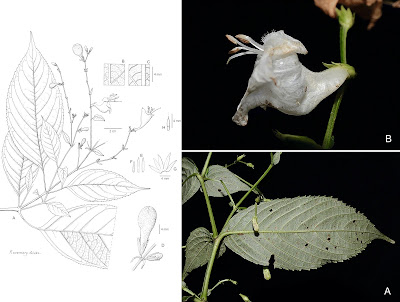 |
| Strobilanthes hians J.R.I.Wood & K.Armstr., in Wood, Aung, Wells & Armstrong, 2022. |
Summary
A brief history of the discovery of Strobilanthes species in Myanmar is presented. The revival of fieldwork in recent years has resulted in many new records, so an updated checklist of all known species from the country is needed. Selected specimens are cited and distribution notes provided. One new species, Strobilanthes hians J.R.I.Wood & K.Armstr., with unusual pollen, is described and illustrated bringing the total of recognised species in the country to 81 with six additional infraspecific taxa.
Keywords: Kachin, Naga Hills, Natma Taung, Sagaing, Shan, species description
 |
| Strobilanthes hians J.R.I.Wood & K.Armstr., A abaxial leaf surface and stem; B flower. PHOTOS: K. ARMSTRONG. |
Strobilanthes hians J.R.I.Wood & K.Armstr., sp. nov.
RECOGNITION. The gaping subcampanulate corolla with four exserted stamens immediately stands out as it is a relatively unusual character found in very few other species of Strobilanthes. This species appears to be closest to S. rostrata Y.F.Deng & J.R.I.Wood from Yunnan in China in its slightly unequal, glabrous or near glabrous leaves, terminal inflorescence with branched leafless spikes and ±linear bracts and bracteoles but differs in the glabrous calyx, bracts and bracteoles (not thinly glandular-pilose), and the white tomentellous corolla (not blue, not glabrous). It might also be compared with S. helicta T.Anderson but the inflorescence of S. helicta is clearly axillary and the corolla is glabrous and strongly ventricose. The pollen is of an unusual type superficially similar to that of S. japonica (Thunb.) Miq., S. oligantha Miq. and its allies (Deng et al. 2006: 372) but clearly ellipsoid in shape and with tectum apparently absent.
ETYMOLOGY. The specific epithet is in reference to the gaping shape of the open corolla.
John R. I. Wood, Mu Mu Aung, Tom Wells and Kate E. Armstrong. 2022. Strobilanthes Blume (Acanthaceae) in Myanmar, A New Species and An Updated checklist. Kew Bulletin. DOI: 10.1007/s12225-022-10033-4
